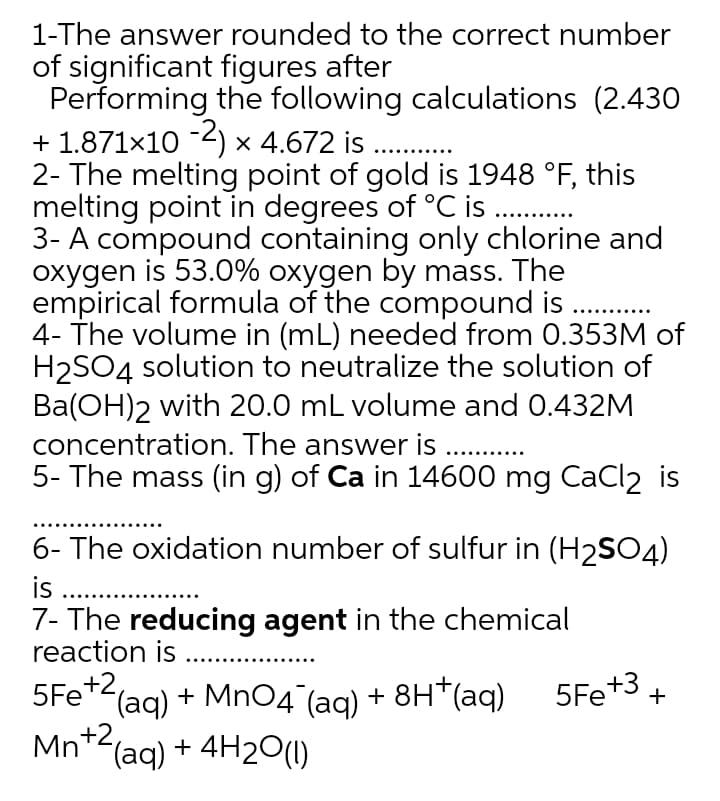Introductory Chemistry: A Foundation
9th Edition
ISBN:9781337399425
Author:Steven S. Zumdahl, Donald J. DeCoste
Publisher:Steven S. Zumdahl, Donald J. DeCoste
Chapter2: Measurements And Calculations
Section: Chapter Questions
Problem 3QAP: When a large or small number is written in standard scientific notation, the number is expressed as...
Related questions
Question
2

Transcribed Image Text:1-The answer rounded to the correct number
of significant figures after
Performing the following calculations (2.430
+ 1.871x10 -2) × 4.672 is
2- The melting point of gold is 1948 °F, this
melting point in degrees of °C is .
3- A compound containing only chlorine and
oxygen is 53.0% oxygen by mass. The
empirical formula of the compound is . .
4- The volume in (mL) needed from 0.353M of
H2SO4 solution to neutralize the solution of
Ba(OH)2 with 20.0 mL volume and 0.432M
concentration. The answer is
5- The mass (in g) of Ca in 14600 mg CaCl2
6- The oxidation number of sulfur in (H2SO4)
is .
7- The reducing agent in the chemical
reaction is .
+2
+3 +
(aq) + MnO4°(aq) + 8H*(aq) 5Fe
Mn*2(aq) + 4H20(1)
5Fe
Expert Solution
This question has been solved!
Explore an expertly crafted, step-by-step solution for a thorough understanding of key concepts.
This is a popular solution!
Trending now
This is a popular solution!
Step by step
Solved in 2 steps

Knowledge Booster
Learn more about
Need a deep-dive on the concept behind this application? Look no further. Learn more about this topic, chemistry and related others by exploring similar questions and additional content below.Recommended textbooks for you

Introductory Chemistry: A Foundation
Chemistry
ISBN:
9781337399425
Author:
Steven S. Zumdahl, Donald J. DeCoste
Publisher:
Cengage Learning

Chemistry: Principles and Reactions
Chemistry
ISBN:
9781305079373
Author:
William L. Masterton, Cecile N. Hurley
Publisher:
Cengage Learning

Introductory Chemistry: A Foundation
Chemistry
ISBN:
9781337399425
Author:
Steven S. Zumdahl, Donald J. DeCoste
Publisher:
Cengage Learning

Chemistry: Principles and Reactions
Chemistry
ISBN:
9781305079373
Author:
William L. Masterton, Cecile N. Hurley
Publisher:
Cengage Learning